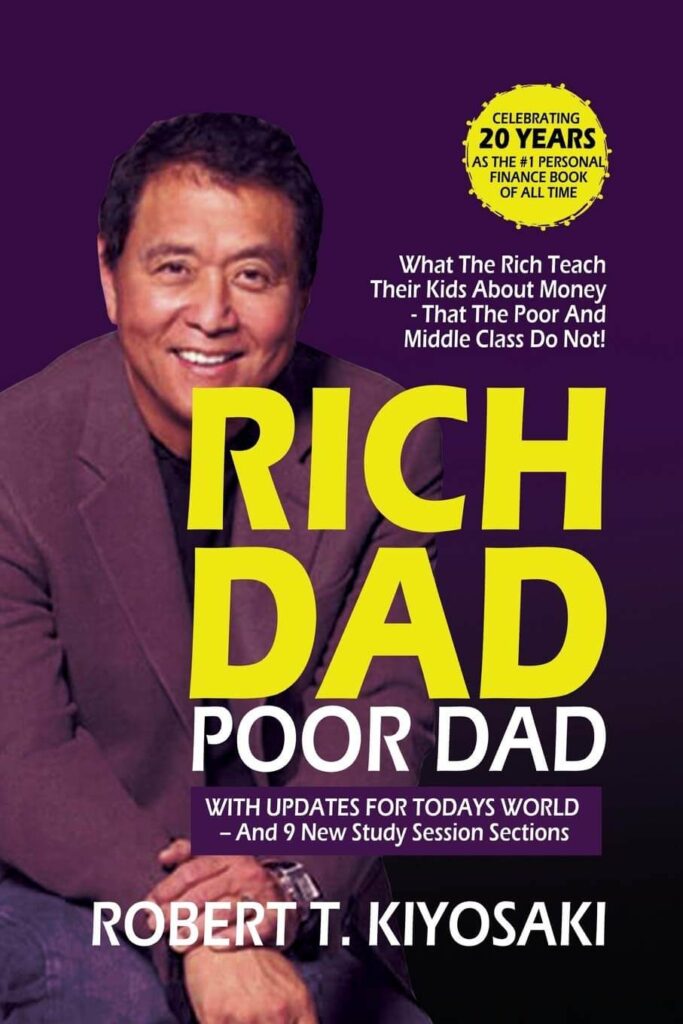‘Rich Dad Poor Dad’ is a bestselling personal finance book by Robert Kiyosaki.
It presents Kiyosaki’s ideas on financial literacy and education through the story of his upbringing and the lessons he learned from two father figures – his own biological father (poor dad) and his best friend’s father (rich dad).
I first read Rich Dad Poor Dad after my boyfriend’s boss bought it as a present for him.
Both my boyfriend and his boss are very financially literate, and so I figured that if they both found value in this book, then there was really something to be gained from it.
After reading it all the way through, and dipping back into it over the past year or so whenever I want to refresh myself of one of the specific lessons in the book, I can honestly say that Rich Dad Poor Dad has taught me a lot about money, and my money mindset has shifted massively in many ways thanks to Kiyosaki’s lessons.
However, it can be tough to find time to read an entire book, and so I decided to put together a Rich Dad Poor Dad summary so that if you’re pressed for time but still want all of Kiyosaki’s wisdom, you can find it right here.
Here’s my Rich Dad Poor Dad book summary and review.
Rich Dad Poor Dad Summary and Review
Rich Dad Poor Dad Overview
The book begins with Robert Kiyosaki describing his childhood, in which he grew up with his biological father, who was a highly educated government employee but struggled financially.
He then introduces his best friend Mike’s father, who he calls ‘Rich Dad.’
Rich Dad was a successful entrepreneur who taught Kiyosaki about money and investing at a young age, which was a stark contrast to the traditional teachings of his biological father.
Kiyosaki explains that Rich Dad taught him that wealth is built through acquiring assets and that income-generating investments are the key to financial freedom.
Rich Dad advocates for financial literacy and emphasises that the poor and middle class work for money, while the rich have their money work for them.
He stresses the importance of taking control of your financial education and developing a strong money mindset.
Throughout the book, Kiyosaki offers various tips and strategies for building wealth, including living below your means, avoiding debt, investing in real estate, and starting a business.
He also emphasises the importance of continuously educating yourself on financial matters and learning from your mistakes.
6 Key Lessons From the Book:
- The rich don’t work for money
- The importance of financial literacy
- Minding your own business
- Taxes and corporations
- The rich invent money
- The need to work to learn and not to work for money
Chapter Summary of Rich Dad Poor Dad
Chapter 1 – Rich Dad Poor Dad
The tale of Robert Kiyosaki and Mike commences in 1956 in Hawaii, when they are just nine years old, eager to learn the ways of amassing wealth from Mike’s father, also known as Rich Dad.
The first lesson they learned was to abhor the ‘Rat Race.’
The way Rich Dad instilled this in them was by making them work in one of his grocery stores for three hours, for just 10c per hour.
Within a few weeks, Kiyosaki became fed up with being taken advantage of and demanded a raise, but instead, Mike’s father slashed his pay and told him to work for free.
Both boys became disillusioned and they each met with Mike’s father.
In these meetings, Rich Dad apologised for the lack of pay and offered them a choice between learning a valuable lesson or receiving a pay raise.
Although rich dad offered them pay raises of 25c, a dollar, 2 dollars, and even 5 dollars per hour (a substantial amount at the time), the boys still opted to learn the moral of the story.
The moral was to break free from the ‘Rat Race,’ and instead of toiling your entire life to earn a little money for yourself and a lot of money for someone else, you should work hard to have people put money in your pocket.
Key points from Chapter 1
- Trading your time for money is not fair or sustainable
- Being at the mercy of a boss who can lower your wages as they see fit is not sustainable
- Having a pay rise still means you are working for someone else
- You should aim to have other people making money for you rather than you making money for other people
Chapter 2 – The Rich Don’t Work for Money
In Chapter 2, Kiyosaki explains why he believes that the rich don’t work for money.
He argues that most people are trapped in a cycle of working hard for money, spending it on expenses, and then having to work even harder to make ends meet.
He believes that the rich have a different mindset and approach to money, and that this is what allows them to build wealth and achieve financial freedom.
Kiyosaki argues that in order to become wealthy, one must learn to create assets that generate income, rather than just relying on a job or a paycheck.
He introduces the concept of the ‘cash flow’ quadrant, which divides people into four categories based on their approach to making money: employees, self-employed individuals, business owners, and investors.
Kiyosaki believes that the most effective way to build wealth is to transition from the left side of the quadrant (employees and self-employed individuals) to the right side (business owners and investors).
He also stresses the importance of financial education and developing a strong understanding of money and investing.
Kiyosaki argues that the traditional school system teaches people to be employees, but not entrepreneurs or investors, which can lead to a lack of financial literacy and skills.
Overall, Chapter 2 of Rich Dad Poor Dad sets the foundation for Kiyosaki’s philosophy on wealth-building and encourages readers to think differently about money and their approach to earning it.
Key points from Chapter 2
- Most people are trapped in a cycle of working for money, spending it on expenses, and working to make more money
- The rich have a different money mindset than the poor, and this is what allows them to prosper
- In order to get rich, you must generate assets that make income
- Employees and self-employed people should transition to business owners or investors if they want to make more money
- We all have a responsibility to financially educate ourselves
- The traditional school system teaches us to be employees and join the Rat Race
Chapter 3 – Why Teach Financial Literacy
In this chapter, Robert Kiyosaki emphasises the importance of teaching financial literacy, both in schools and at home.
He argues that many people are not taught basic financial skills or the importance of financial education, which can lead to a lifetime of struggle and financial insecurity.
Kiyosaki believes that financial literacy and a working knowledge of accounting is crucial when it comes to building wealth and achieving financial freedom.
He argues that people need to understand the difference between assets and liabilities, as well as how to generate income from assets.
For example, he points out that many poor people believe that owning property is the best asset one can have, but that if you can’t actually afford the upkeep of that property, it ceases to be an asset and instead becomes a liability.
Bills, taxes, renovations and repairs are all things that cost money, and if a large portion of your income is being sucked up by your property every month, then your asset is draining your wealth rather than working for you, which is what an asset is supposed to do.
He also stresses the importance of understanding taxes and how they can affect one’s income and net worth.
He then compares his ‘Rich Dad’ with his ‘Poor Dad,’ who was highly educated but struggled financially due to a lack of financial education.
He finishes by arguing that financial education should be taught in schools and that it should also be a priority for parents to teach at home.
He suggests that people should read books on personal finance and investing, attend seminars and workshops, and seek out mentors who can teach them valuable skills and strategies.
Key points from Chapter 3
- Not learning basic financial skills can lead to a lifetime of poverty and financial hardship
- To make money, you have to understand money
- There is a difference between an asset and a liability
- You should make an effort to understanding taxes
- Financial education should be taught both in the home and at school
- We should all be making great efforts to understand personal finance and investing
Chaper 4 – Mind Your Own Business
Next, Kiyosaki introduces the concept of real estate investing by using McDonald’s as an example.
Although they may not make the best burgers, McDonald’s own some of the most valuable locations in the world, and that the true business of McDonald’s is real estate.
Kiyosaki goes on to emphasise the importance of minding one’s own business (as in, focusing on developing their own businesses rather than their employer’s businesses).
The chapter also explores the idea of building assets, which can include stocks, bonds, real estate, and intellectual property.
Robert cites real estate and stocks as his personal preferences when it comes to assets.
He then shares that his strategy for real estate investing is all about starting small and trading up to larger properties, while also delaying paying taxes on capital gains through an IRS mechanism.
Key points from Chapter 4
- McDonald’s is in the business of real estate, not burgers
- You should focus on minding your own business rather than somebody else’s
- Assets can include stocks, bonds, real estate, and intellectual property
- Robert’s strategy for real estate investing is buying small and trading up to larger properties while delaying paying taxes on capital gains
Chaper 5 – The History of Taxes and the Power of Corporations
This chapter is all about the differences between how the rich and the poor use corporations.
While the poor allow themselves to be manipulated by corporations, the rich know how to use them to protect and grow their assets.
Kiyosaki points out that corporations have a tax advantage over individuals, as they only pay taxes on what’s left after expenses.
In contrast, individuals pay taxes on their income before any expenses are deducted.
Kiyosaki repeats his argument from the previous chapters, which is that developing financial intelligence (knowledge of accounting, investing, and the law), is crucial for escaping the daily grind, and that being uninformed leads to being bullied, while being informed gives you a fighting chance.
Key points from Chapter 5
- The poor get screwed over by corporations while the rich use them to their advantage
- Owning a corporation gives you a tax advantage because you only pay taxes on what’s left after expenses
- Being informed gives you a fighting chance at success
Chapter 6 – The Rich Invent Money
This part of the book talks about the concept of self-doubt and how it hinders an individual’s success.
According to the Kiyosaki, everyone is born with talent, but it remains suppressed due to fear and self-doubt (also known as a fixed mindset).
He suggests that it’s not only the educated and intelligent who succeed, but the bold and adventurous as well.
He highlights that financial success is not simply about having money, but about creating opportunities and taking advantage of them.
One example of this is hiring people who are more intelligent than you in order to capitalise on their knowledge and build your own knowledge base, which ultimately leads to having more power, and more money.
Key points from Chapter 6
- Fear and self-doubt suppress your talents and hinder your success
- The bold and adventurous are just as likely to succeed as the educated and intelligent
- You should always be creating opportunities and taking advantage of them
Chapter 7 – Work to Learn, Don’t Work for Money
Chapter 7 emphasises the skills individuals must develop to achieve financial success.
Using the example of a young woman with a Master’s Degree in English Literature, who was offended when advised to learn sales and marketing in order to succeed, Robert highlights the importance of cultivating other skills to achieve financial freedom.
He discusses the need for management skills, including cash flow, systems, and people management, as well as the importance of selling, marketing, and communication skills.
While many individuals have a wealth of knowledge, they may lack the communication skills needed to succeed. According to Robert, these individuals are ‘one skill away from great wealth.’
Key points from Chapter 7
- In order to succeed, we must master a variety of skills
- Valuable skills include management skills, sales, marketing, and communication skills
Chapter 8 – Overcoming Obstacles
There are 5 personality traits that hinder people: fear, cynicism, laziness, bad habits, and arrogance.
Robert emphasises that fear is normal but that it’s important to handle it appropriately.
He praises the focus and winning mentality of Texans, and advises people to ignore the pessimistic ‘Chicken Littles,’ with their trivial worries, and instead to focus on what lies ahead.
Lastly, Kiyosaki believes it’s healthy to be greedy and that people should always ask, ‘What’s in it for me?’ when making decisions.
Key points from Chapter 8
- Fear, cynicism, laziness, bad habits, and arrogance are the 5 personality traits that really hinder people in the pursuit of wealth
- Don’t worry about trivial things – try to focus on the bigger picture
- It’s fine to be greedy
Chapter 9 – Getting Started
Chapter 9 is where Robert really dives into the specifics about how to all about how to begin building personal wealth.
His first recommendation is to find a motivating reason that is bigger than reality to awaken the financial genius within yourself and empower the mind with a strong sense of purpose.
The second tip in this chapter is to nourish the mind, as doing so gives people the power to choose.
Kiyosaki advises readers to be mindful of their friends, avoiding those who are overly negative and actively seeking out those who enjoy discussing money, as they may have valuable lessons to offer.
Paying oneself first is another suggestion that the Kiyosaki makes (even if money is tight), as managing cash flow is a critical component of financial success.
His next piece of advice is to have heroes, as they inspire and make things seem attainable, encouraging people to think, ‘If they can do it, why can’t I?’
Finally, Kiyosaki shares the idea that ‘Teach and you shall receive,’ stressing that you should be generous with your knowledge and your help in order to receive help and wisdom from others.
Key points from Chapter 9
- Find a large motivating reason to begin building wealth
- Surround yourself with people who can teach and inspire you
- Have heroes whose success you can try to emulate
- Be generous with your time, wisdom, and help
Chapter 10 – Want More? Here Are Some to-do’s
This final chapter is an extension of the previous one, offering more tips and nuggets of financial advice.
Tips include:
- Cease doing what no longer works for you
- Seek the advice of people who have achieved what you aim to achieve
- Maintain a learning mindset – attend seminars, take courses etc.
Rich Dad Poor Dad Summarised
All in all, the central message of Rich Dad Poor Dad is that in order to achieve wealth, one must strive to own the means of production (the business) instead of working for someone else, and that being an employee can limit one’s mindset and stifle creativity.
Financial intelligence is the most valuable asset one can possess.
By learning accounting and investing principles, individuals can distinguish between assets and liabilities and understand the importance of building genuine assets rather than incurring expenses.
Corporations have a unique advantage over individuals, as they can earn money, spend what they want, and only pay taxes on what remains. The wealthy understand how to leverage this advantage, while the poor do not.
Kiyosaki states that true luxury is only attained when material possessions are the tangible results of intelligent investing and asset building, and cautions against the tendency to keep up with others.
He advises everybody to live within their means rather than snapping up the latest luxury product and going into debt as a result.
Lastly, he argues that fear, laziness, cynicism, bad habits, and arrogance are the main obstacles to success.
Rich Dad Poor Dad – My Verdict
Now that I’ve given you a Rich Dad Poor Dad summary of each chapter and the advice within, I want to talk about my personal opinions of the book.
Manny critics have argued that Kiyosaki oversimplifies complex financial concepts and that his advice doesn’t apply to all situations, which is certainly true.
Rich Dad Poor Dad is not a step-by-step instruction manual on what to do in order to get rich, nor is it a replacement for a proper financial education.
However, to somebody that knows very little about finance (like me), Rich Dad Poor Dad was very accessible, and it certainly motivated me to get my finances in order and figure out how to make my money work for me.
For example, it changed my mind about owning a property before I am really ready to, and opened up the world of investing to me (I’ve since invested some of my savings in the stock market and put the rest in bonds).
Rich Dad Poor Dad also made me realise that both of my parents have the ‘Poor Dad’ mentality, which has drastically shaped my financial situation and my money mindset.
For example, while my parents have instilled in me the ability to save money and budget accordingly, I’ve always been steered away from investing because it was seen as too much of a risk.
I’ve also never been in an environment where the want to be rich was there – my parents have never had the same financial drive that, say, my partner has.
Rich Dad Poor Dad has taught me that it’s not only okay to want wealth, but that it’s actually feasible for someone like me (which I’ve never thought before).
While the book doesn’t give any specific or detailed tutorials on how to invest or build wealth, it does introduce you to the principles so that you can then go and learn the rest yourself, making it a great starting point for someone at the beginning of their financial journey.
The tone of the book is conversational, often funny, and never boring, and it’s a very easy book to pick up and put down whenever you feel like it.
The core message of Rich Dad Poor Dad is that anything is possible with a mindset shift, and that the way you think about money shapes your financial success.
I thoroughly enjoyed the book, and would definitely recommend it to anybody thinking of buying it!
So, that’s about it for my Rich Dad Poor Dad summary, but as always, if you have any questions at all, don’t hesitate to reach out and ask me in the comments section.
Until next time!
XOXO






[…] money at a 9 – 5, and learn how to make your money work for you (one of the key lessons in Rich Dad, Poor Dad), you have the time to focus on the things that make you feel happy and […]